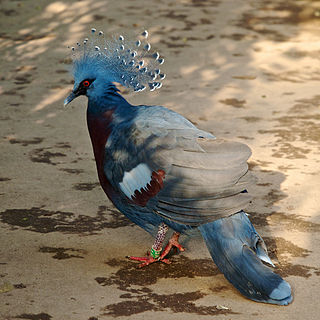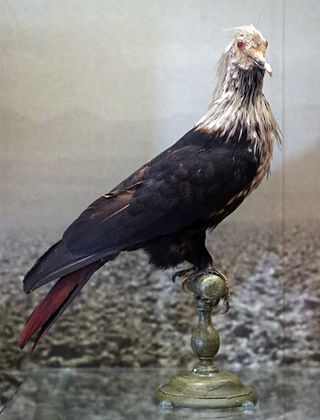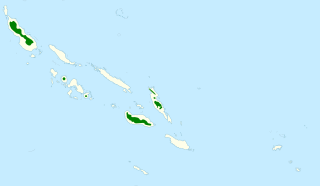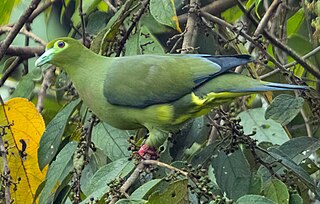
The emerald dove or common emerald dove, also called Asian emerald dove and grey-capped emerald dove, is a widespread resident breeding pigeon native to the tropical and subtropical parts of the Indian Subcontinent and Southeast Asia. The dove is also known by the names of green dove and green-winged pigeon. The common emerald dove is the state bird of the Indian state of Tamil Nadu. The Pacific emerald dove and Stephan's emerald dove were both considered conspecific.

The orange-breasted green pigeon is a pigeon found across tropical Asia south of the Himalaya across parts of the Indian Subcontinent and Southeast Asia. Like other green pigeons, it feeds mainly on small fruit. They may be found in pairs or in small flocks, foraging quietly and moving slowly on trees. The nape is blue-grey and the crown is yellowish green. The uppertail coverts are bronzed and the undertail coverts are unmarked rufous. The male has a pinkish band on the upper breast with a broader orange one below while the female has a bright yellow breast.

The superb fruit dove, also known as the purple-crowned fruit dove, is a medium-sized, colourful fruit-dove in the family Columbidae.

The Victoria crowned pigeon is a large, bluish-grey pigeon with elegant blue lace-like crests, maroon breast and red irises. It is part of a genus (Goura) of four unique, very large, ground-dwelling pigeons native to the New Guinea region, with the Victoria crowned pigeon measuring as the largest extant species of pigeon. The bird may be easily recognized by the unique white tips on its crests and by its deep 'whooping' sounds made while calling. Its name commemorates the British monarch, Queen Victoria.

The Mauritius blue pigeon is an extinct species of blue pigeon formerly endemic to the Mascarene island of Mauritius in the Indian Ocean east of Madagascar. It has two extinct relatives from the Mascarenes and three extant ones from other islands. It is the type species of the genus of blue pigeons, Alectroenas. It had white hackles around the head, neck and breast and blue plumage on the body, and it was red on the tail and the bare parts of the head. These colours were thought similar to those of the Dutch flag, a resemblance reflected in its French common name, Pigeon Hollandais. The juveniles may have been partially green. It was 30 cm (12 in) long and larger and more robust than any other blue pigeon species. It fed on fruits, nuts, and molluscs, and was once widespread in the forests of Mauritius.

Wallace's fruit dove is a species of a bird in the pigeon family Columbidae. The name commemorates the British naturalist Alfred Russel Wallace. It is a rather large, long-tailed fruit dove with a length of 24–28 cm (9.4–11.0 in) and has been described as "one of the most beautiful" fruit doves. The forehead and crown are dull crimson, the lower face and throat are white, and the rest of the head, breast, neck, and upper back are pale bluish-grey. The wings and lower back are green and the belly is orange, separated from the chest by a white band. Both sexes look similar, but females have less extensive red on the head and a greenish tinge to their grey parts.

The Christmas imperial pigeon or Christmas Island imperial pigeon, also known as Black imperial pigeon, Dusky imperial pigeon, Wharton's imperial pigeon, or burong pergam, is a large imperial pigeon endemic to Christmas Island in the northeastern Indian Ocean. It has an overall grey-blue colouration, and juveniles are duller than adults. It makes a soft purring coo sound and a deeper whoo sound comparable to a cow mooing. It lays one glossy white egg per brood, and is possibly somewhat colonial.

The tambourine dove is a pigeon which is a widespread resident breeding bird in woodlands and other thick vegetation in Africa south of the Sahara Desert. Its range extends from Senegal east to Ethiopia and Kenya and southwards through eastern Africa to south-eastern South Africa, but it is absent from the drier areas of south-western Africa. There is a population on the Comoros Islands.

The blue pigeons are a genus, Alectroenas, of birds in the dove and pigeon family Columbidae. They are native to islands in the western Indian Ocean.

The Comoro blue pigeon is a species of bird in the family Columbidae. It is endemic to the Comoros and the coralline Seychelles. It is rated as a species of near threatened on the International Union for Conservation of Nature Red List of Endangered Species.

The black wood pigeon or Japanese wood pigeon is a species of bird in the family Columbidae. It is found in East Asia along shorelines of the Pacific's Korea Strait, Philippine Sea and East China Sea. It is believed to be the largest representative of the genus, Columba, and has a weight of around 550 grams (1.2 lb) and an overall length of 43 cm (17 in). Its natural habitats are temperate forests and subtropical or tropical moist lowland forests. The species is in decline owing to habitat loss, habitat degradation, deforestation and hunting. This wood pigeon is endemic to the laurel forest habitat.

The pale mountain pigeon is a species of bird in the pigeon family Columbidae. It is endemic to the Solomon Islands archipelago, where it inhabits old-growth and secondary montane forest. It is a medium-size pigeon with an average length of 38 cm (15 in) and a weight of 310–385 g (10.9–13.6 oz). The head and neck are whitish-grey, the belly and lower breast are buffy-pink, and the vent and undertail coverts are pale grey. The upperparts are smoky-grey with darker fringes on the mantle and wing coverts. Both sexes look similar, but there can be large variation in individual appearance.

The white-headed fruit dove is a species of bird in the pigeon family Columbidae. It was described by the English ornithologist John Gould in 1856, and the specific name eugeniae honours the French empress Eugénie de Montijo. Adults of the species have white heads, a purplish-red breast patch, a grey shoulder patch, olive-green upperparts, greenish underparts with a blue tinge, and a yellowish vent. Juveniles have green heads with the white restricted to the forehead and upper throat, a much smaller grey shoulder patch, and the red breast patch restricted to the centre of the breast.

The Sumatran green pigeon is a species of bird in the pigeon family, Columbidae. First described by the Dutch zoologist Coenraad Jacob Temminck in 1823, it is endemic to Indonesia, where it is found in Sumatra and western Java. It inhabits the canopy of dense hill and montane forest and has been recorded at elevations of 350 to 1,800 m on Sumatra and 600 to 3,000 m on Java. The Sumatran green pigeon is a relatively slender species with a long wedge-shaped tail and an adult length of 29.0–34.1 cm (11.4–13.4 in) in males and 27.7–29.0 cm (10.9–11.4 in) in females. Adult males have a dark green head and body, bright yellow lower belly and undertail-coverts, dark grey tail, and bluish-green unfeathered patches on the face. Adult females are duller and have no grey on the back of the neck, a fainter orange wash on the breast, and no orange markings on the crown or the bend of the wing.

The black cuckoo-dove or black dove, also known as the slaty cuckoo dove, is a species of bird in the family Columbidae. It is endemic to the Lesser Sunda Islands, being found on Timor, Wetar, Rote, and Atauro. It inhabits primary and secondary monsoon forest, eucalyptus forest, and woodlands. It is 38.5 cm (15.2 in) long on average and is mainly dark bluish-gray, lighter on the head and underparts and darker on the wings and tail. It has yellow orbital skin.

The Pacific emerald dove or brown-capped emerald dove is a pigeon which is a widespread resident breeding bird in the tropical and sub-tropical parts of Indonesia to northern and eastern Australia. It was formerly conspecific with the common emerald dove.

The fruit doves, also known as fruit pigeons, are a genus (Ptilinopus) of birds in the pigeon and dove family (Columbidae). These colourful, frugivorous doves are found in forests and woodlands in Southeast Asia and Oceania. It is a large genus with over 50 species, some threatened or already extinct.





















